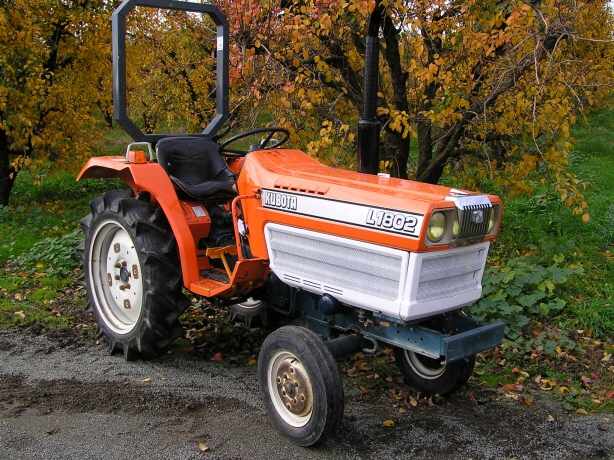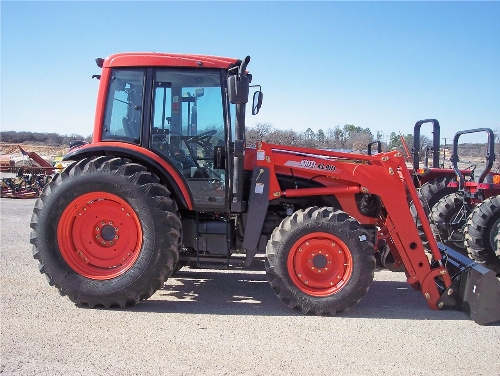The “other” Orange Tractor. Kioti.
The web is littered with Kubota versus Kioti discussions where various owners hem and haw trying to weigh the benefits and advantages of each. This post is going to step back from the fray and instead provide a bit of Kioti’s history and how it relates to Kubota because the two companies do have some history together.
An Overview
Kioti is manufactured by Daedong, a South Korean company that has been in the tractor business for about 60 years. Kioti is actually only used for their North American equipment, everywhere else, like nearby Australia for instance, they are known simply as a Daedong tractor. Daedong launched its Kioti lineup in 1986 but it was not until the early 1990s that they started to make headway in the North American market and become recognized in any serious numbers. Today there are more than 250+ Kioti dealerships in Canada and the United States compared to Kubota’s 1000+. Like Kubota they perform the majority of manufacturing in their home country and then perform final assembly and warehousing in one of three major centers: California, Texas and North Carolina.
In the Early Days
In the early 1980s Kubota from Japan and Daedong from Korea teamed up to build what is known as the Kubota “02” series of tractors, namely the L1802, L2002, L2402, L2602 and L2802. It was a joint venture with Daedong manufacturing the transmission and Kubota providing its experience with the engine mechanics and other components. Interestingly, Daedong provided the design and fabricated the body sheet metal for these tractors which gives them their own distinctive look – no other Kubota looks like these tractors do. Despite the team effort, the “02” tractors are still largely Kubotas with exception of their transmissions which means many parts for them are still available today. Production of these tractors lasted from the early 1980s, peaked in 1983 and then tapered off.
Lawsuits and Bad Blood
It is no secret that a Kioti tractor, with its orange coloring scheme, similar hood shape and decal lettering look an awful lot like a Kubota. Their names even start with the same letter, K! It seems that just about the only thing Daedong didn’t do was call their tractor a Kiboti. In either case, the bad blood started shortly after their relationship together in the early to mid 1980s. Kubota suspected its partner of stealing engineering secrets and repurposing them for its Daedong’s own gain, a big no-no. The aggression spilled over in late 2002 when Kubota filed a lawsuit against Kioti in a California district court. Kubota felt its trademark coloring and hood designs were being infringed upon and also sought to clear the air regarding confusion between Kubota and Kioti – there were strictly not one in the same.
A Settlement is Reached
The lawsuit dragged on for 5 years until August 2007 when a press release issued by both companies stated that the matter had been resolved – the amount of the settlement undisclosed. It is interesting to note however that Kioti still relies heavily on its orange color scheme much like Kubota and its hood designs and decals also look similar, so one can only speculate on what sort of agreement the two companies came to.
Kioti’s Equipment Lineup
Today, Kioti’s lineup spans the 19 through 90 horsepower range with its impressive new-for-2007 DK90 sitting atop. Not all that long ago Kioti did not have very many hydrostatic/HST models available in its lineup and they still do not have a larger TLB to compete with Kubota’s more commercial grade L39 or L48. And although they do not have as wide of product range (no answer back to Kubota’s mower or RTV models), they do have implement and mower deck support for their existing lineup – not a bad place to be.
Bottom Line
Arguments abound as to which manufacturer gives you more “bang for your buck”. Some argue that Kubota’s are overpriced compared to a similarly equipped Kioti, others provide anecdotal evidence of higher resale on Kubota’s lineup. Some take a neutral path – go with whichever dealership gives you the best deal or that is closest so you can get parts and service quickly. Kubota? Kioti? What we do know for sure is that as these two manufacturers continue to expand their product lines, the compact utility tractor landscape is going to get a bit more crowded and a lot more orange!
Related Articles
Discovered it’s a Gray Market Kubota? Relax.
Common Kubota Terms Explained
Kubota Parts, Service and Operator’s Manuals – Get Them








Norman Riggs Said,
December 8, 2008 @ 6:34 pm
I need to buy a new radiator for my ,quite old , I think 25 years at least, Kubota Tractor,a B6000. can you supply ? and what would the price be ? I’m in Powell River, BC., I’ve been quoted a price of $250 to have it repaired here, Which is probably cheaper than a new one?
Thanks, Norman Riggs.
Vic Said,
December 10, 2008 @ 9:17 pm
Norman,
The $250 sounds about right to re-core that B6000 Radiator. I had a couple of B7001’s done in the spring and they came in just under $300 a piece.
If the tanks are still good, and usualy they are, then re-coring is fine. Early Kubota B Series tractors, North American and JDM versions are famous for radiator rot. A new Kubota radiator is available for just south of $600. Remember, Kubota does not sell reconditioned parts so that the price of a new one!
We have access to aftermarket units, but our supplier does not make one for the B6000.
Thanks for checking out our site!
Service Dept Vic
ibrahim Said,
June 23, 2009 @ 5:13 am
Hi
I have a L1501DT Kubota tractor. There is a arm under the seat( It is gear). I don’t know to use it(when). I am writing you from North Cyprus( Mersin 10 TURKEY). Would you help me.
ibrahimkobat@yahoo .com
Evan Jones Said,
December 29, 2009 @ 2:33 am
Good day. I have a b7800 with 285 hours on it. My fuel indicator rarely shows below the full level, even though it is obvious that the tank may be well below 1/2. Any ideas?.
Thanks, and a great web site!.